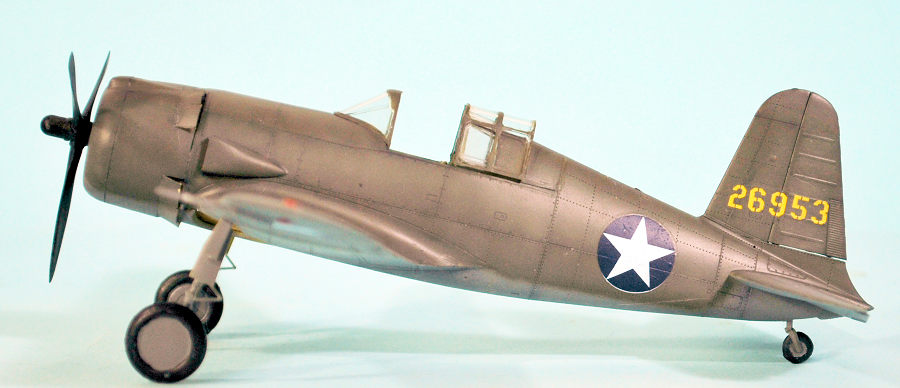
| KIT #: | DW48050 |
| PRICE: | $35.00 |
| DECALS: | Four options |
| REVIEWER: | Tom Cleaver |
| NOTES: | Short run |

| HISTORY |
The Vultee Vanguard was the result of a concept conceived in the late 1930s by the Vultee Aircraft Division of the Aviation Manufacturing Corporation, of developing four aircraft designed for different roles from a set of common wings and aft fuselage and tail assemblies. The company assigned four model designations: V-48 to a single-seat fighter, BC-51 to a basic combat trainer, B-54 to an advanced trainer, and BC-54D as a basic trainer. Eventually, the BC-51 became the Army Air Corps BC-3 and the BC-54D was adopted as the BT-13/SNV-1 Valiant, the most widely-used USAAF trainer in World War II.
Design of the V-48 fighter known as the Vanguard began in 1938 under the leadership of Richard W. Palmer. The design featured an all-metal semi-monocoque fuselage and fully retractable landing gear, with power provided by a Pratt & Whitney R-1830 air-cooled radial engine giving 1,200 hp. During construction of the first prototype, a decision was made to lengthen the propeller shaft and install a tight cowling to provide a pointed nose to reduce drag. The first aircraft flew in September 1939 piloted by Vance Breese, and was assigned registration number NX21755. On May 9, 1940, the prototype collided with a Lockheed Sirius while landing at Vultee airfield, the impact severing one main undercarriage leg. Nevertheless, Breese skillfully landed the airplane with little additional damage. It was subsequently rebuilt with an orthodox cowling.
Flight tests revealed the Vanguard suffered from inadequate cooling. Measures to modify the cooling ducting were unsuccessful. After re-evaluating the design, and noting that the insignificant drag decrease was not worth the added weight and ducting problems, the second prototype, the V-48X, was modified with a conventional cowling and the first prototype was similarly modified. The second prototype first flew February 11, 1940. As a result of flight tests, a number of changes were made to the design including substantially increasing the size of the horizontal and vertical tail surfaces
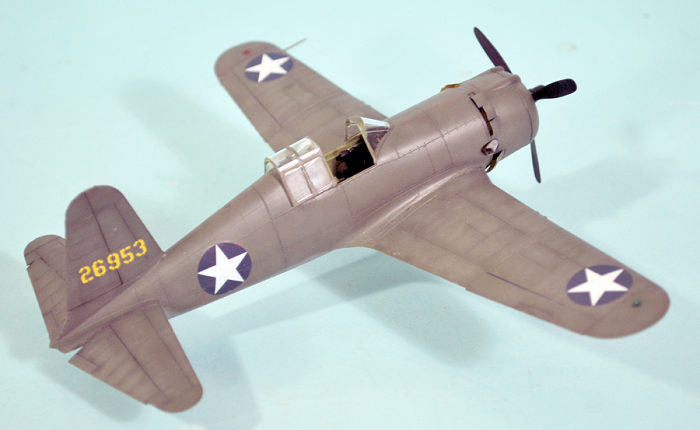 Just
before the first flight of the second prototype, Vultee received orders for 144
fighters from Sweden. This version received the company designation Model 48C
and the Swedish Air Force designation J10.
Just
before the first flight of the second prototype, Vultee received orders for 144
fighters from Sweden. This version received the company designation Model 48C
and the Swedish Air Force designation J10.
The model 48C flew for the first time on September 6th, 1940, powered by the export version of the Pratt & Whitney R-1830-33 engine rated at 1,200 h.p. for take off and 1,050 h.p. at 13,100 feet. Armament was two .50 caliber machine guns synchronized to fire through the propeller arc and four .30 caliber machine guns in the wings. Weights were 5,237lbs empty, 7,100lbs normal gross, and 7,384lbs maximum. Maximum speed was 340 mph at 15,100 feet. Initial climb rate was 2,520 fpm, taking 9 minutes to reach 19,680ft. Service ceiling was 28,200ft.
By the time the first model 48C flew in late summer 1940, the Germans had overrun Denmark and Norway. Fearing that Germany might take over Sweden, the State Department rescinded the Swedish export license.
The V-48 did not meet British requirements for a first-line fighter but the RAF agreed to accept 100 to be used as advanced fighter trainers in Canada. They were named "Vanguard" and were assigned the serial numbers BW208 to BW307. The July 1941 edition of the magazine “Aeronautics” had a photograph of Canadian World War One ace Air Marshall William Bishop, V.C., in front of a Vanguard in RAF livery at the Downey, California factory. The caption stated the fighter was powered by a 1,600hp engine and credited it with an unconfirmed maximum speed of 400 mph.
In November 1940, the Chinese purchasing commission, in Washington to procure warplanes for three American Volunteer Groups led by Claire Chennault, listed the Vultee fighter as one of the fighters that would meet Chinese requirements. After obtaining 100 P-40s, the Chinese sought radial engine fighters to complete the balance of their 350 fighters. By mid-1941 $238 million in Lend-Lease financing of had been made available to the Chinese including $50 million for aircraft.
In May 1941 the British gave up the Vanguards in favor of the Chinese, with initial deliveries scheduled for the autumn of 1941 and final shipments in the spring of 1942. In keeping with Lend-Lease requirements the Vanguards were assigned to the USAAF where they were designated P-66 with serial numbers 42-6832 to 42-6975.
By the end of the year 39 P-66s had been delivered to the USAAF. Following the Pearl Harbor attack, they were assigned to the 14th Pursuit Group, based at March Field outside Riverside, California.
The history of the 14th Fighter Group describes the Group's experience with the P-66 as follows:
 "The
pilots of the 14th Pursuit Group actually liked their P-66s, and they described
the P-66 as being a very good aerobatic aircraft. Test pilot Gil Clark thought
it was the best aircraft he had ever flown, being much better than the Curtiss
P-36. However, the cockpit layout was rather poor, and the aircraft was not
sufficiently robust for a fighter. In addition the P-66 had a disconcerting
tendency to ground loop, soon 15 examples being lost to this sort of accident."
"The
pilots of the 14th Pursuit Group actually liked their P-66s, and they described
the P-66 as being a very good aerobatic aircraft. Test pilot Gil Clark thought
it was the best aircraft he had ever flown, being much better than the Curtiss
P-36. However, the cockpit layout was rather poor, and the aircraft was not
sufficiently robust for a fighter. In addition the P-66 had a disconcerting
tendency to ground loop, soon 15 examples being lost to this sort of accident."
Some pilots of the 14th Pursuit Group may have liked the P-66 but the comments "very good aerobatic aircraft" and "best aircraft ... ever flown" are not consistent with the unsatisfactory report submitted by the group to the 4th Air Service Command at the end of January 1942, which included a long list of faults, most of a minor nature, not atypical of such reports on new aircraft. However, among the deficiencies noted were: "correct slow maneuverability" and "correct high wing loading". Such comments implied a substantial redesign or reconfiguration of the aircraft was needed and not just minor engineering adjustments.
The office of the Chief of the Experimental Engineering Section at Wright Field recommended that no modifications to the P-66 be made, that they be removed from operations and their future disposition be investigated. On March 6th, 1942, the first P-66s left Los Angeles aboard ship bound for China.
The 20 P-66s in the first shipment arrived at Karachi in May 1942. Eventually 128 P-66s were shipped from the U.S. and 104 arrived at Karachi. The others were lost when the ship carrying them was torpedoed.
By July,the Middle East crisis eased and work on assembling the P-66s resumed. The first 20 were assembled, tested and accepted by the Chinese in arly August; a further 51 were in India being assembled or awaiting testing.
The ROCAF 3rd Fighter Group sent pilots to Karachi in July 1942 to ferry P-66s to China. By mid-August the first six P-66s were ready to start the long journey across India. The transfer flight across India did not go smoothly. By the end of September Col. Loo, the ROCAF representative at Karachi, requested the U.S. furnish pilots to take charge of transition training at Karachi.
By November 8, 1942, 104 P-66s had arrived; 81 had been accepted by the Chinese and 61 had been flown to China. Ten others were ready to fly; the final 19 had been completed and delivered to the flight section.
Of the 81 P-66s accepted by the Chinese, 10 crashed at Karachi during training. Three crashed at Jodhpur, the first leg of the ferry route. As of December 11, 1942, there were still 15 P-66s at Karachi
Two months later General Stillwell pointed out that the Chinese had not used any of the aircraft purchased with Lend-Lease funds in combat. He suggested that if additional fighters were available they should go to the Tenth Air Force. The day after Stillwell's radiogram, ROCAF fighters put on a demonstration over Chungking where Stillwell had his headquarters.
The P-66s flew 16 sorties from 25-27 October and four more sorties on November 10, to intercept Japanese reconnaissance aircraft but no interceptions were made. The P-66 was not particularly well suited to intercept high altitude reconnaissance planes.
At the beginning of 1943 ROCAF fighters were stationed at bases near Chungking and Chengtu to provide air defense.During January 1943 the P-40s and P-43s flew a few combat missions from Liangshan and Kweilin. During February the 4th Fighter Group P-43s were in action again losing a fighter without claiming any victories. The P-66s remained at their bases near Chungking and Chengtu and saw no combat.
June 6, 1943 was the high water mark of the P-66's combat career. The action began with a ROCAF mission against Niehkiako by three A-29s escorted by 13 P-40s and eight P-66s. Ground targets were bombed and strafed. One P-40 went down to ground fire. After the mission the P-40s returned to their base at Liangshan while the P-66s returned to Peishiyi by way of Enshih.
The Japanese sent formations against both Liangshan and Enshih. At Liangshan eight Type 99 Ki-48 bombers of the 90th Flying Regiment were escorted by fourteen Ki-43 fighters of the 33rd Flying Regiment. The formation of eight light bombers sent against Enshih was unescorted.
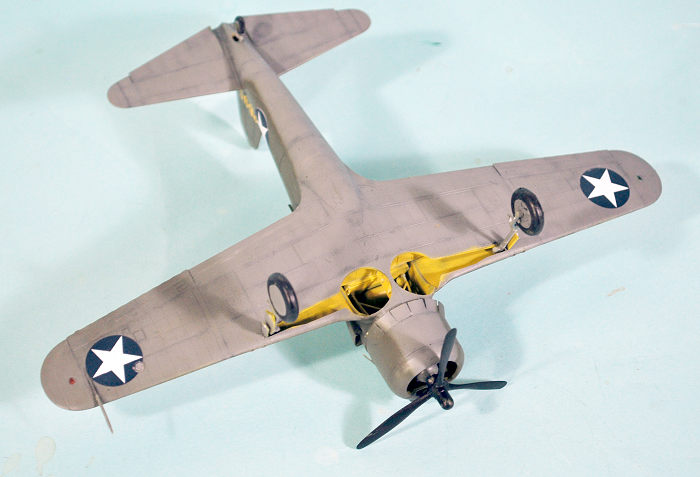 East of
Enshih P-66s encountered the unescorted bombers that had just attacked the
airfield. Chen Zhaoji of the 41st Squadron shot down a Ki 48.
East of
Enshih P-66s encountered the unescorted bombers that had just attacked the
airfield. Chen Zhaoji of the 41st Squadron shot down a Ki 48.
At Liangshan the last Chinese pilot to land was Capt. Chow Chi-Kai, squadron leader of the 23rd Squadron who landed with his fuel tanks almost empty.
Chow saw eight planes approaching from the north. He got in a P-66 and taxied to take off without taking time to adjust his parachute, buckle his safety belt or close his canopy. He was still in his take off run when bombs exploded on the runway just behind him and machine gun bullets hit nearby. Immediately after takeoff, he caught and attacked the flight leader, then a second bomber. With his seat belt still unfastened and cockpit open, Chow attacked a third bomber, with his landing gear still extended. The bomber burst into flames. He then fired a burst into the leader's right engine, which poured heavy black smoke and the bomber headed down.
Chow finally adjusted his parachute and safety belt and retract ed the landing gear. He caught up with the third bomber and aimed for the cockpit, firing a long burst. The bomber spun into the ground.
For shooting down three enemy bombers, Chow received the Blue Sky - White Sun award from Chiang Kai-Shek; he was soon promoted Major and appointed acting Group commander.
After the successful interception by the 11th Group P-66s the Chinese fighters pulled back to Chungking and Chengtu. The P-66 squadrons had 46 fighters of which 39 were serviceable.
They next saw action on August 23 when the Japanese bombed Chungking for the first time in two years. 31 Ki.43s escorted 27 Ki-21 Type 97 bombers of the 58th Flying Regiment. The Chinese scrambled ten P-40s, eight P-43s, and eleven P-66s. Several P-43s managed to attack the bombers before the escort intervened, scoring one bomber. The Japanese claimed a P-40, two P-43s and an unidentified fighter as well as three P-43s uncertain. The Chinese lost a P-40, a P-43 and at least two P-66s.
The P-66s saw their final action on November 21 when four P-66s ran across Japanese fighters and all were lost with three pilots killed without any positive result. After this the P-66 was removed from combat status and used for training until May 1945, when the P-66 was retired from service.
The P-66 showed itself to be a mediocre aircraft at best, with no outstanding qualities. Historical data suggests that deficiencies in organization, doctrine, training and leadership more than the quantity or quality of its aircraft were the primary factors that undermined the effectiveness of the ROCAF.
| THE KIT |
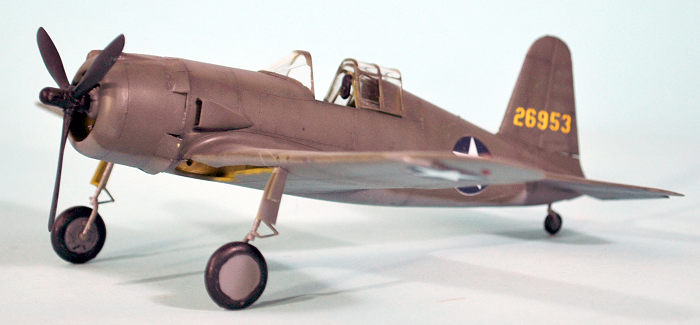 For
some reason, modelers have long been interested in this airplane. There have
been two 1/72 scale P-66s and a very primitive 1/48 limited run kit released
some 20-odd years ago that I am aware of. The new kit from Dora Wings makes all
of those earlier kits obsolete.
For
some reason, modelers have long been interested in this airplane. There have
been two 1/72 scale P-66s and a very primitive 1/48 limited run kit released
some 20-odd years ago that I am aware of. The new kit from Dora Wings makes all
of those earlier kits obsolete.
Like all other Dora Wings kits, this is accurate, with good interior and surface detail and very clear canopy parts. Construction is different from more mainstream kits, due to production limitations of the company’s molding machines. However, with care, one can create an excellent model from what is in the box.
Decals are provided for a Vanguard Mk. I and the first J.10, which was in unpainted aluminum. Two “what if” markings are provided for Swedish J.10s.
| CONSTRUCTION |
When working on a Dora Wings kit, one must always remember that they will get a Tamiya/Eduard result if they treat the kit as a “high end limited run” project. Test fit everything four times before gluing once. Following that advice, while the kit is challenging to assemble, will result in a very nice model.
All the flying surfaces have the over/under trailing edge, which allows
for knife-edge trailing edges. Sand the interior of the lower part, test fitting
it, till there is perfect fit with the upper part. Then flood the are of the
over/under mating line of the upper part, and attach the lower, pressing it till
glue squirts out. This will fill the gap and all you have to do is scrape the
line of squeezed-out glue after it sets up, minimizing destruction of surface
detail. On the wing, you cannot avoid having to fill and sand that gap in the
area of the flaps. I restored the rivet detail with my pounce
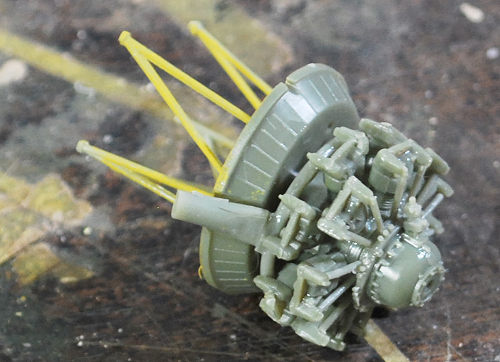 wheel and
once painted there is no sign of any gap.
wheel and
once painted there is no sign of any gap.
With regard to the cockpit, the seat is too large. I replaced that with an “extra” seat from an Airfix P-40B kit, but anything out of the spare parts box will work.
I attached the engine mounts to the backplate of the engine, rather than the firewall, since it is easier to get it attached this way, and all one has to do is slide the completed engine into position.
The fuselage area where the upper wing attaches needs to be thinned down at least 50% on the mating surface, so that there is no ridge when the two sub-assemblies are brought together. Test fit here a lot to get it right. Glue one upper wing to the fuselage and let it set up before gluing the other side, then use a rubber band to increase dihedral enough to get a strong fit. Flood the joint and let it set up. After it is set, when you remove the rubber band, it will assume proper dihedral.
Scrape the mating surface of the horizontal stabilizer totally flat, apply lots of glue to both surfaces, press hard and you will not have a joint that has to be filled.
Looking at photos, none of the operational P-66s used the power wheel covers, so I left them off.
| COLORS & MARKINGS |
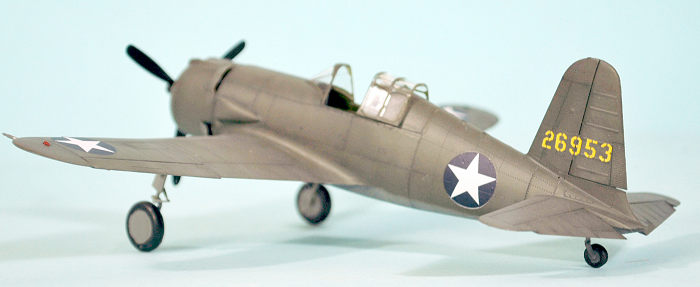 I
pre-shaded the model, then used Tamiya Neutral Grey and RAF Dark Green for the
camouflage, lightened with grey to simulate sun fading. I used US national
insignia and serial numbers to produce a P-66 as seen at Karachi in 1942. Other
photos of P-66s operational in China show that they retained US insignia when
used by the ROCAF.
I
pre-shaded the model, then used Tamiya Neutral Grey and RAF Dark Green for the
camouflage, lightened with grey to simulate sun fading. I used US national
insignia and serial numbers to produce a P-66 as seen at Karachi in 1942. Other
photos of P-66s operational in China show that they retained US insignia when
used by the ROCAF.
I attached the landing gear with CA glue to get a strong attachment since there is nothing in the wheel well to hold the gear. I scraped down the leading edge of the rear cockpit glass to allow the canopy to be posed open in the right position; the canopy cannot be posed closed.
| CONCLUSIONS |
Another excellent model of an obscure airplane from Dora Wings. If you take care in assembly, you will get an excellent model. Recommended for those with experience in building “high end limited run” kits.
13 April 2023
Copyright ModelingMadness.com. All rights reserved. No reproduction in part or in whole without express permission.
Review kit courtesy of all you book buyers.
If you would like your product reviewed fairly and fairly quickly, please contact the editor or see other details in the Note to Contributors.